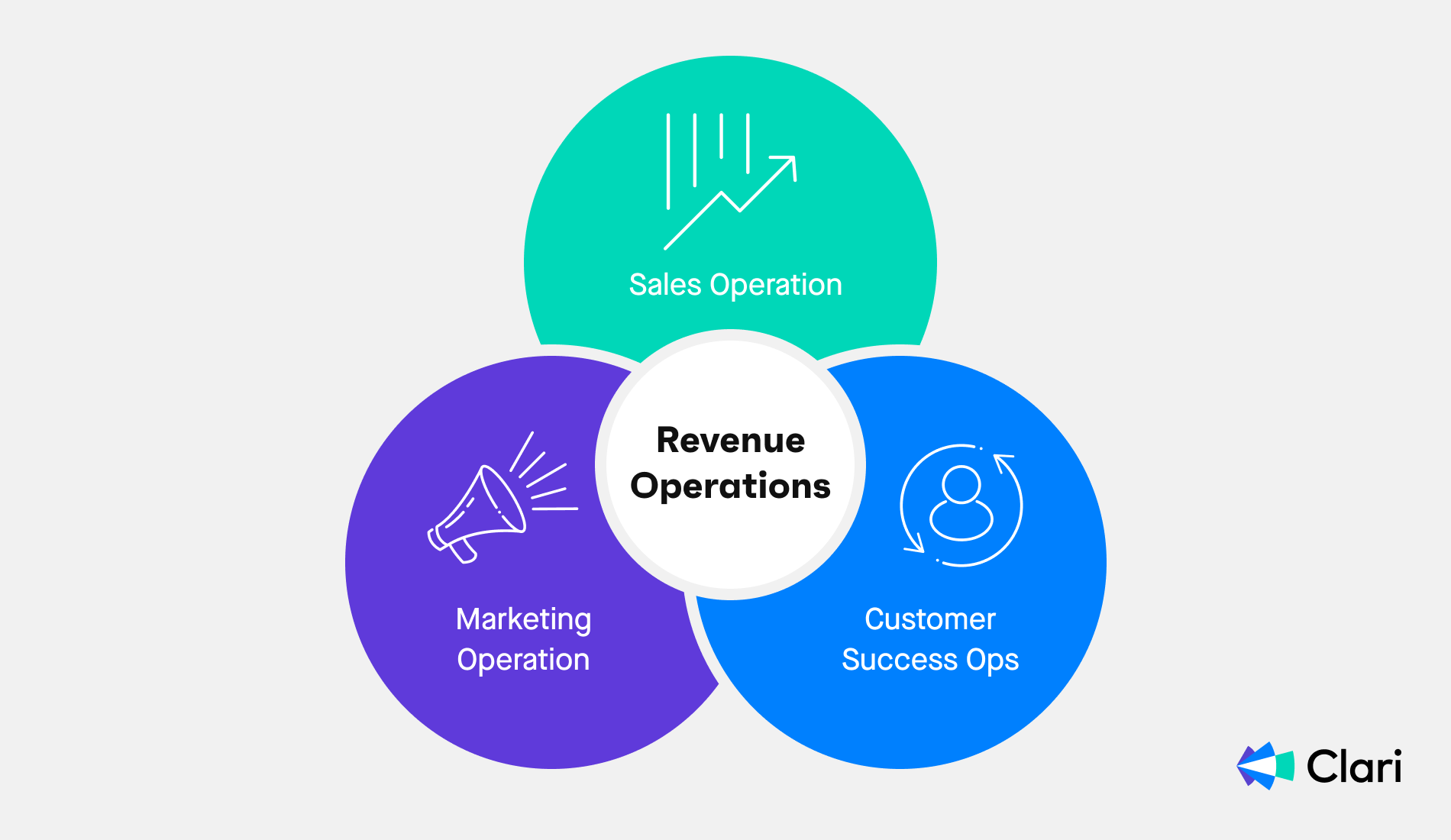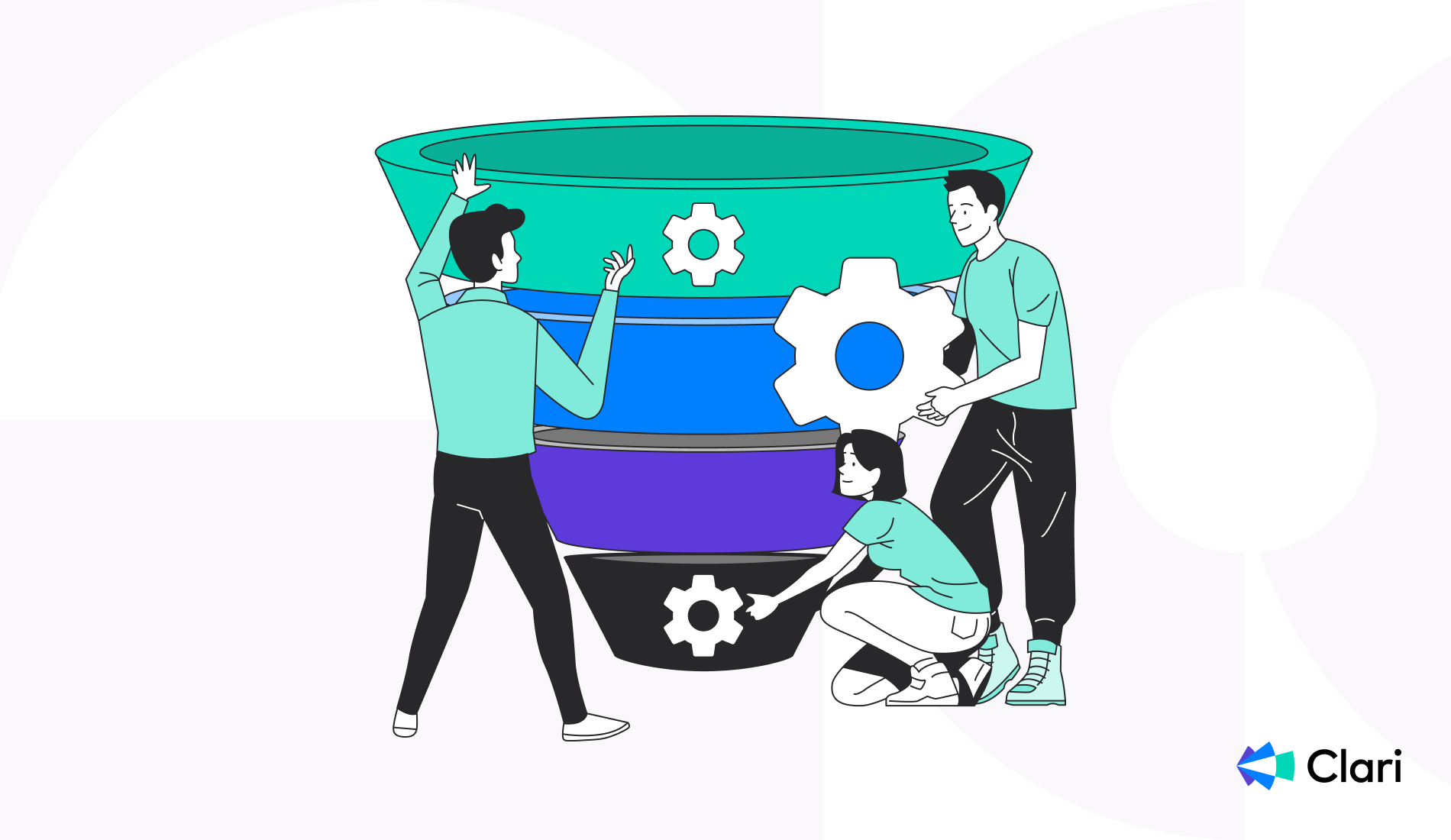You know you’re losing revenue. But you’re unsure if you need to improve your sales processes, concentrate on marketing, or manage customer churn.
If you focus on driving sales, but the problem lies in customer success, you’ll waste your efforts.
This is why knowing the difference between revenue operations (RevOps) and sales operations (SalesOps) is important.
Understanding how the two differ helps you figure out which approach will help you capture more revenue to power growth.
Let’s learn how these methodologies work, what sets them apart, and how you choose which approach works best for your team’s needs.
Table of Contents:
- What are revenue operations?
- What are sales operations?
- 3 key differences between revenue operations vs. sales operations
- Revenue operations vs sales operations: Which function is best for your business?
- How do you combine both revenue operations and sales operations
- What's next?
What are revenue operations?
Revenue Operations, often called RevOps, acts like a strategic coach for your team, unifying the sales, marketing, and customer success departments so everyone’s playing from the same rule book.

Its main purpose is to ensure these teams work in unison to boost revenue coherently and strategically. Instead of each team operating in isolation, RevOps encourages these departments to combine insights and data, create shared goals, and build cross-departmental strategies to help you achieve your company-wide goals.
The main functions of RevOps are:
- Team integration: RevOps bridges different departments within your company to align everyone’s objectives so they synchronize their efforts toward common goals.
- Data-driven insights: RevOps leverages data and advanced technology to predict market trends and customer needs. These insights help your teams work together to make better strategic decisions based on real-world experiences.
- Enhance customer experience: A core focus of RevOps is understanding the customer journey to improve the overall experience, from initial engagement to post-purchase. RevOps help you create seamless experiences at every customer touchpoint by aligning your teams.
- Drive revenue coherently: RevOps helps you identify and harness revenue opportunities at all pipeline stages by linking departments and sharing insights across teams.
But what are the true benefits of revenue operations?
Firstly, it streamlines decision-making. When you have visibility into customer behavior throughout the entire lifecycle, you can better collaborate on strategies that seize those opportunities.
Take WEKA, for example.
Before using Clari for RevOps, the company’s data was so scattered that forecasting and decision-making were slow and inaccurate. Using RevOps tools unifies data management. WEKA now benefits from quick, informed decision-making, reducing quarterly business review time by 80%.
RevOps also increases operational efficiency.
Consider Black Swan.
Without a RevOps tool, the tech company ran forecasts through spreadsheets. With no way to augment the data, Black Swan suffered from a lack of pipeline transparency, slow deals, and inaccurate forecasts. Using Clari to automate key revenue operations, they’ve gained 20+ hours a week by reducing manual work.
You’ll also see customer satisfaction and retention improvements and more cohesive deal management.
RevOps has empowered businesses like UXCam to gain deeper insights into sales interactions. They can now target coaching and skill development to enhance customer engagement.
Or take the development platform, Unity. RevOps's clarity gives them far better visibility into sales performance. Now, they can flag and address issues immediately, leading to a 30% less deal slippage.
|
Ready for a more cohesive approach to revenue operations? See Clari in action. |
What are sales operations?
Where RevOps combines sales, marketing, and customer success, Sales Operations, or SalesOps, focuses on your sales processes.

Here’s what SalesOps does:
- Fine-tunes sales processes: SalesOps delves into how your sales team works and redesigns the processes so sales operations run better.
- Equips the team: SalesOps ensures your sales team has the best tools to do their job. This might involve installing new sales software, upgrading training materials, or restructuring the team.
- Spots trends and issues: SalesOps identifies patterns or problems in your sales data to help your team better understand what’s working and what’s not.
But why bother with SalesOps? What are the benefits of diving into sales processes?
First, SalesOps helps your sales team reduce time-wasting activities that detract your team from selling.
It also streamlines the sales journey. It equips your team with everything they need to swiftly bring a buyer through the process while ensuring no bottlenecks are slowing down the journey.
SalesOps also gives your teams better targets for which to aim. By honing in on what works, your sales team will find it easier to follow one clear path to selling success.
And ultimately, it boosts your bottom line. With a straightforward sales journey and a highly-equipped sales team, it’s easier to sell more faster.
3 key differences between revenue operations vs. sales operations
Though they share some common goals, RevOps and SalesOps have different approaches and focuses.
Let’s dive into three key distinctions that set them apart.
1. Cross-departmental vs. individual team
RevOps aims to synchronize efforts across your teams to reach unified revenue goals. It improves operations throughout the customer journey, from lead generation to customer retention.
SalesOps is concerned only with sales team alignment. It focuses on sales-specific practices and tools that'll improve the effectiveness of sales reps and streamline the sales funnel.
2. Different metrics to measure success
The RevOps team uses key metrics that apply across marketing, sales, and customer success, such as annual recurring revenue (ARR), customer lifetime value (CLTV), and revenue retention rate. These metrics gauge the impact of collaborative strategies across departments.
SalesOps only focuses on sales metrics, like close rates, average deal size, and sales pipeline velocity. These metrics concern the efficiency and effectiveness of sales functions and practices.
3. Tactics to achieve goals
RevOps professionals use tactics that bring together insights to improve decision-making across the organization. Strategies aim to unify data, integrate tech stacks, automate consecutive processes, and create fluidity in the customer journey.
SalesOps concentrates only on tactics that relate to sales processes. This might look like sales tech management, targeted sales training, or sales process optimization.
Revenue operations vs sales operations: Which function is best for your business?
Choosing between revenue operations and sales operations can feel tricky. It comes down to your organization’s unique needs and business growth priorities.

First, think about your company’s size and structure.
Is your company relatively mature, with well-established sales, marketing, and customer success teams, but struggles to work together smoothly?
RevOps puts everyone on the same page, helping you generate upscale revenue to build sustainable growth through strategic planning and exceptional customer experiences.
But, if your business is smaller and in the early stages of growth, you’re more likely to focus your energy on generating sales.
SalesOps functions to refine sales strategies to boost your bottom line quickly so you establish yourself in the market and build capital within your organization.
Next, consider how your operations function.
If your main revenue leaks are from operational issues like scattered data or unclear goals, RevOps unifies business practices so they work as more than the sum of their parts.
Conversely, you might find that revenue issues are local to your sales department, like high dropout rates or slow sales processes. SalesOps steps in to smooth out these operations and plug the leaks where they occur.
You also need to think about sales complexity.
If your company operates with a multi-step sales process, you’ll benefit from RevOps' integrated approach. It looks at the big picture to work out how to streamline the customer experience throughout the entire funnel.
For straightforward sales processes that aim for quick wins, SalesOps makes it easier for customers to serve themselves by removing friction in the buying process.
Let’s look at a quick example to see how this works:
RevOps: F5 Networks is a Fortune 1000 company with mature sales, marketing, and customer success departments. However, the cloud security company found that CRM issues, poor collaborative processes, and a lack of centralized data left teams struggling to understand why revenue generation was slow.
Using Clari, the company consolidated data, knowledge, and processes so everyone could understand where bottlenecks occur and how to fix them. This is a great example of revenue operations in action.
SalesOps: Imagine a small startup company with a small team and no formal departments. Since it’s just taking off, it focuses on boosting sales in the early growth stage.
There’s no need for departmental integration since the team’s so small. Instead, it’d refine its sales strategies and processes to accelerate revenue generation and get the project off the ground.
How do you combine both revenue operations and sales operations?
If you have the capacity, there’s strength in combining RevOps and SalesOps. Here are some ways to do this.
Map the customer journey: Draw a map that shows the path your customers take from learning about your product to purchasing. This helps you figure out where customers get stuck so SalesOps can work on improving sales issues while other teams handle their parts.
Unify data and metrics: Take all the pieces of customer information from sales, marketing, and customer success and put them in one place. This gives you a big picture of how to make the company more money and where each team can improve.
Align goals: When everyone in marketing, sales, and customer service has the same goals, it's easier to collaborate.
Automate workflows: Use technology to do repetitive tasks, like sending emails or processing customer data. This way, sales reps spend more time talking to customers and making sales, while your marketing and customer success departments can concentrate on supporting sales at either end of the funnel.
What's next?
Revenue operations offer an integrated understanding of how every aspect of your operational processing affects your revenue.
By combining sales, marketing, and customer success teams, you can identify revenue leaks, predict future opportunities, and combine efforts and intelligence to drive growth.
Clari empowers your team to drive revenue by providing a single source of truth so everyone knows how and where to collaborate effectively.
Data is defragmented and driven by powerful metrics and insights, so it flows seamlessly up and down the organization. That way, everyone knows where and how to harness their efforts, so you’re prioritizing impactful improvements to see real results.
Ready to harmonize your revenue cadence? Check out Clari in action.


